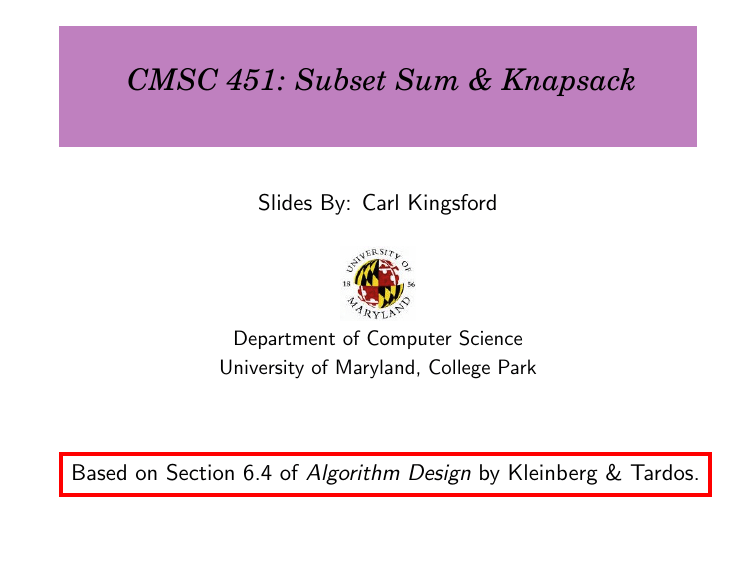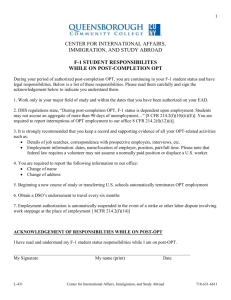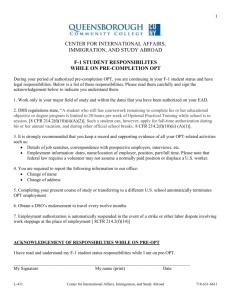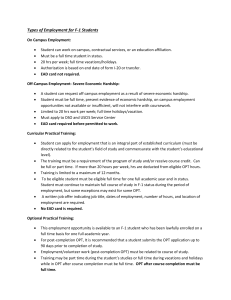CMSC 451: Subset Sum & Knapsack
advertisement

CMSC 451: Subset Sum & Knapsack
Slides By: Carl Kingsford
Department of Computer Science
University of Maryland, College Park
Based on Section 6.4 of Algorithm Design by Kleinberg & Tardos.
Subset Sum
Subset Sum
Given:
• an integer bound W , and
• a collection of n items, each with a positive, integer weight wi ,
find a subset S of items that:
P
P
maximizes i∈S wi while keeping i∈S wi ≤ W .
Motivation: you have a CPU with W free cycles, and want to
choose the set of jobs (each taking wi time) that minimizes the
number of idle cycles.
Assumption
We assume W and each wi is an integer.
Optimal Notation
Notation:
• Let S ∗ be an optimal choice of items (e.g. a set {1,4,8}).
• Let OPT (n, W ) be the value of the optimal solution.
• We design an dynamic programming algorithm to compute
OPT (n, W ).
Subproblems:
• To compute OPT (n, W ): We need the optimal value for
subproblems consisting of the first j items for every knapsack
size 0 ≤ w ≤ W .
• Denote the optimal value of these subproblems by OPT (j, w ).
Recurrence
Recurrence: How do we compute OPT (j, w ) given solutions to
smaller subproblems?
(
OPT (j − 1, W )
if j 6∈ S ∗
OPT (j, W ) = max
wj + OPT (j − 1, W − wj ) if j ∈ S ∗
Special case: if wj > W then OPT (j, W ) = OPT (j − 1, W ).
Another way to write it. . .
(j − 1, W )
if wj > W
OPT(
OPT (j, W ) =
OPT (j − 1, W )
if j 6∈ S ∗
max
wj + OPT (j − 1, W − wj ) if j ∈ S ∗
Note: Because we don’t know the answer to the blue questions, we
have to try both.
The table of solutions
OPT(n, W)
9
0
8
0
7
0
6
0
5
0
4
0
3
0
2
0
1
0
0
0
0
0
0
0
0
0
0
0
0
0
0
0
0
1
2
3
4
5
6
7
8
9
10
11
12
OPT(4, 11)
Filling in a box using smaller problems
OPT(j-1, W-wj)
9
0
8
0
7
0
6
0
5
0
4
0
3
0
2
0
1
0
0
0
0
0
0
0
0
0
0
0
0
0
0
0
0
1
2
3
4
5
6
7
8
9
10
11
12
OPT(j, w)
OPT(j-1, W)
Filling in a box using smaller problems
OPT(j-1, W-wj)
9
0
8
0
7
0
6
0
5
0
4
0
3
0
2
0
1
0
0
0
0
0
0
0
0
0
0
0
0
0
0
0
0
1
2
3
4
5
6
7
8
9
10
11
12
OPT(j, w)
OPT(j-1, W)
Remembering Which Subproblem Was Used
When we fill in the gray box, we also record which subproblem was
chosen in the maximum:
OPT(j-1, W-wj)
9
0
8
0
7
0
6
0
5
0
4
0
3
0
2
0
1
0
0
0
0
0
0
0
0
0
0
0
0
0
0
0
0
1
2
3
4
5
6
7
8
9
10
11
12
OPT(j, w)
OPT(j-1, W)
Filling in the Matrix
Fill matrix from bottom to top, left to right.
9
0
8
0
7
0
6
0
5
0
4
0
3
0
2
0
1
0
0
0
0
0
0
0
0
0
0
0
0
0
0
0
0
1
2
3
4
5
6
7
8
9
10
11
12
When you are filling in box, you only need to look at boxes you’ve
already filled in.
Pseudocode
SubsetSum(n, W):
Initialize M[0,w] = 0 for each w = 0,...,W
Initialize M[i,0] = 0 for each i = 1,...,n
For i = 1,...,n:
For w = 0,...,W:
If w[i] > w:
M[i,w] = M[i-1,w]
for every row
for every column
case where item can’t fit
M[i,w] = max(
which is best?
M[i-1,w],
w[j] + M[i-1, W-w[j]]
)
Return M[n,W]
Finding The Choice of Items
Follow the arrows backward starting at the top right:
9
0
8
0
7
0
6
0
5
0
4
0
3
0
2
0
1
0
0
0
0
0
0
0
0
0
0
0
0
0
0
0
0
1
2
3
4
5
6
7
8
9
10
11
12
Which items does this path imply?
Finding The Choice of Items
Follow the arrows backward starting at the top right:
9
0
8
0
7
0
6
0
5
0
4
0
3
0
2
0
1
0
0
0
0
0
0
0
0
0
0
0
0
0
0
0
0
1
2
3
4
5
6
7
8
9
10
11
12
Which items does this path imply? 8, 5, 4, 2
Runtime
Runtime:
• O(nW ) to fill in the matrix.
• O(n) time to follow the path backwards.
• Total running time is O(nW ).
This is pseudo-polynomial because it depends on the size of the
input numbers.
Knapsack
Knapsack
Given:
• a bound W , and
• a collection of n items, each with a weight wi ,
• a value vi for each weight
Find a subset S of items that:
P
P
maximizes i∈S vi while keeping i∈S wi ≤ W .
Difference from Subset Sum: want to maximize value instead of
weight.
How can we solve Knapsack?
How can we solve Knapsack?
Knapsack
Subset Sum:
(
OPT (j − 1, W )
if j ∈
6 S∗
OPT (j, W ) = max
wj + OPT (j − 1, W − wj ) if j ∈ S ∗
Knapsack
Subset Sum:
(
OPT (j − 1, W )
if j ∈
6 S∗
OPT (j, W ) = max
wj + OPT (j − 1, W − wj ) if j ∈ S ∗
Knapsack:
(
OPT (j − 1, W )
OPT (j, W ) = max
vj + OPT (j − 1, W − wj )
if j 6∈ S ∗
if j ∈ S ∗
Fractional Knapsack
0-1 Knapsack
You’re presented with n, where item i has value vi and size wi .
You have a knapsack of size W , and you want to take the items S
so that
P
•
vi is maximized, and
Pi∈S
•
i∈S wi ≤ W .
This is a hard problem. However, if we are allowed to take
fractions of items we can do it with a simple greedy algorithm:
• Value of a fraction f of item i is f · vi
• Weight of a fraction f is f · wi .
Knapsack Example
Idea: Sort the items by pi = vi /wi
Larger vi is better, smaller wi is better.
$30
1
$40
p1 = 30
2
$45
p2 = 20
$100
knapsack size = 6
p3 = 15
3
p4 = 25
4
1
$30
4
+
$100
1/2
+
(1/2)*$40
= $150
0-1 Knapsack
This greedy algorithm doesn’t work for 0-1 knapsack, where we
can’t take part of an item:
$30
1
$40
p1 = 30
2
$45
p2 = 20
$100
knapsack size = 6
Greedy Choice:
p4 = 25
4
1
$30
A better choice:
p3 = 15
3
4
+
$100
4
= $130
2






